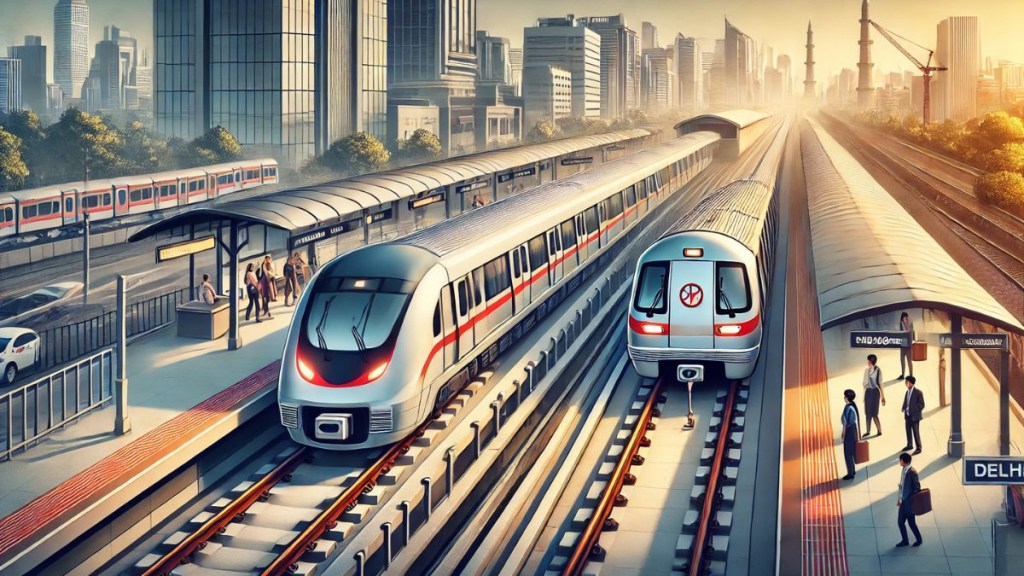The National Capital Region Transport Corporation (NCRTC) has unveiled the groundbreaking speed and efficiency of the Regional Rapid Transit System (RRTS), a rail-based, high-speed transit network designed to revolutionise connectivity in the National Capital Region (NCR). According to NCRTC, the RRTS will be three times faster than the existing metro systems.
With a design speed of 180 kilometers per hour and an operational speed of 160 kilometers per hour, the RRTS promises to dramatically reduce travel time across the NCR. The average speed for the system will be 100 kilometers per hour, making it capable of covering distances much more swiftly than metro networks, which have an operational speed of 80 kilometers per hour and an average speed of just 32 kilometers per hour.
RRTS can cover 100 kms in 1 hours
When compared to metro travel, RRTS stands out with its ability to cover 100 kilometers in just 1 hour, in contrast to metro systems which take up to 3 hours for similar distances. This vast difference in travel times positions RRTS as a game-changer for the region, particularly for commuters traveling between suburban areas and urban centers.
The NCRTC Smart Lines, once fully operational, will not only provide faster transit options but also enhance the overall quality of urban mobility. These lines are designed to serve as the backbone of transportation in the region, supporting balanced urban development while offering a sustainable solution to growing transportation demands.
Regional Rapid Transit System Phase 1
The prioritised corridors for Phase 1 of the project span a total of 383.6 km. The first corridor, covering Delhi – Sonipat – Panipat, will stretch over 111 km. The second corridor, connecting Delhi – Ghaziabad – Meerut, will cover 92.6 km, while the third corridor, from Delhi – Gurugram – Rewari – Alwar, will be the longest at 180 km.
Delhi-Ghaziabad-Meerut RRTS
The Delhi-Ghaziabad-Meerut RRTS Line will traverse one of the most densely populated areas of NCR. Beginning at Sarai Kale Khan in Delhi, the corridor extends northward to Modipuram, just beyond Meerut city, connecting key urban centers like Sahibabad, Ghaziabad, Murad Nagar, and Modi Nagar with high-speed transit. The daily ridership on this corridor is expected to exceed 7.95 lakh passengers, marking it as a vital transportation link for the region.
Delhi-Sonipat-Panipat RRTS
The Delhi-Sonipat-Panipat Smart Line will head northwest from Delhi, linking the capital to key towns such as Sonipat, Gannaur, Samalakha, and Panipat in Haryana. Starting at Sarai Kale Khan, the line will pass through significant transit points like New Delhi Railway Station and Kashmere Gate ISBT before continuing towards Panipat. This corridor will serve an area rich in educational and hospitality institutions, positioning it as a major driver of growth and regional development.
Delhi-Gurugram-Rewari-Alwar RRTS
The Delhi-Gurugram-Rewari-Alwar Smart Line will connect the industrialised regions of Haryana to Rajasthan, benefiting areas from Gurugram to Alwar. This corridor will significantly enhance the productivity of commuters traveling from Delhi and Gurugram to key industrial hubs like Manesar, Bawal, and Neemrana. Starting from Sarai Kale Khan, the line will pass through Dhaula Kuan and Mahipalpur in Delhi before heading towards Alwar in Rajasthan, passing through Gurugram, Dharuhera, and Rewari along the way.

